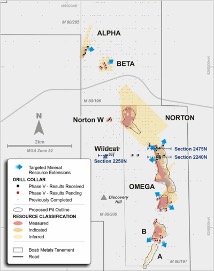Boab drilling unlocking more lead, silver at Sorby Hills
Mining
Mining
Initial assays returning significant intercepts of lead and silver are an indicator that Boab’s latest drill program at the Sorby Hills project has achieved its goals.
Results such as 17m grading 3.39% lead and 15 grams per tonne (g/t) silver from a depth of 58m along with 17m at 3.02% lead and 13g/t silver have confirmed extensions to the mineralised envelope at the Northwest Omega deposit.
Phase V drilling was aimed at testing and validating interpretation of portions of the Sorby Hill’s Resource located near, but outside the current open-pit designs with a view to incorporating these prospective tonnes into the Definitive Feasibility Study (DFS) mine plan and may allow Boab to consider increasing the scale of the project. The DFS is due for release in Q1 CY 2022.
The program also marks the first time that Boab Metals’ (ASX:BML) has targeted the Alpha and Beta deposits, which are not included in the current mining inventory, since acquiring the project in 2018.
Drilling at the Alpha deposit returned a top hit of 4.5m at 2.39% lead and 101g/t silver from 31m, confirming the company’s current geological model as well as its belief that the steeply east-southeast dipping fault breccia lens, which differs from the other Sorby Hills deposits, is the major host to the zinc-silver dominated mineralisation there.
Meanwhile, drilling at the Beta deposit has confirmed that the mineralisation manifests as a stratabound lens akin to that found at the Omega, Norton and B-Deposits, though this is found in the hanging wall of the Knox Formation rather than the footwall location elsewhere.
Both Alpha and Beta represent a significant opportunity for Boab to expand the mining inventory at Sorby Hills, which currently has a resource of 44.9 million tonnes grading 3.2% lead, 37 grams per tonne silver and 0.5% zinc.
Assays are pending for drilling at Beta.
“We are pleased with the results received so far as they confirm the extension of the mineralisation at Omega and very likely at the B-deposit,” managing director Simon Noon said.
“We believe these results will enable us to model the geometry of a new style of mineralisation which we first recognised in the Phase IV drill holes in the north of Omega.”
He added that mineralised intercepts encountered at the Beta deposit had given the company the confidence to commit to additional RC drilling to better define its mineralisation.
“We hold high expectations for the contribution that the Beta Deposit could make to the overall Resource,” he concluded.

Boab drilled 19 holes at the NW Omega resource area to follow-up on encouraging results from the Phase IV drill program and to infill the structurally controlled mineralisation.
Results from this drilling has added at least 120m strike to the stratabound mineralisation northwest of the current boundary of the deposit and is expected to allow the modelling of at least one, and possibly several parallel, east-northeast dipping structures and associated steeply east-dipping mineralisation envelopes over about 500m strike.
While the latter overlaps with the stratabound mineralisation, the company still expects it to add additional tonnage to the resource and definitive feasibility study mining inventory.
The company is also waiting on assays from the 15 holes it drilled to the southeast and northwest of the current resource envelope at the B Deposit.
This is anticipated to extend the existing resource.
Meanwhile, drilling outside the existing resources envelopes at the Wildcat prospect, where previous RC drilling by Boab intersected 15m at 2.81% lead from 10m, returned three intervals of secondary mineralisation from a depth of 5.6m in the same hole.
Intercepts of 4.4m at 2.63% lead and 17g/t silver from 5.6m, 4.5m at 1.26% lead and 9g/t silver from 11m, and 3.5m at 1.6% lead and 17g/t silver from 19.5m were separated by intervals of core loss due to the soluble nature of the host rock.
These confirm the extremely shallow nature of mineralisation and indicate that Wildcat is related to a north-south striking mineralised fault that extends south for at least 1.2km and connects with the Discovery Hill mineralisation.
The company plans to carry out more infill drilling at the Beta deposit before a high confidence resource category can be applied.
As such, it plans to drill 15 reverse circulation holes from September.
The RC rig will then move to drill conceptual targets at E80/5317 (Eight Mile) where soil sampling is currently underway to collect geochemical data to support this planned deep drilling and allow future target refinement.
This article was developed in collaboration with Boab Metals, a Stockhead advertiser at the time of publishing.
This article does not constitute financial product advice. You should consider obtaining independent advice before making any financial decisions.